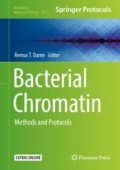Abstract
Nucleoid-associated proteins bind to DNA specifically and nonspecifically to perform various roles in chromosome organization and segregation. In this chapter, we describe how the interaction between nucleoid-associated proteins and flow-stretched DNAs can be visualized on the single-molecule level. We describe three different experimental schemes that allow one to directly observe how these proteins that make up bacterial chromatin, associate with and act on DNAs. First, we describe how to visualize the diffusion of fluorescently labeled proteins on flow stretched DNAs. Second, we describe how the binding of bacterial chromatin proteins can be correlated with DNA condensation. Lastly, we describe the DNA motion capture assay, which allows one to probe the mechanism of DNA condensation by tracking how different segments of a flow stretched DNA are compacted by bacterial chromatin proteins.
Access this chapter
Tax calculation will be finalised at checkout
Purchases are for personal use only
References
Song D, Loparo JJ (2015) Building bridges within the bacterial chromosome. Trends Genet 31(3):164–173. https://doi.org/10.1016/j.tig.2015.01.003
Dame RT (2005) The role of nucleoid-associated proteins in the organization and compaction of bacterial chromatin. Mol Microbiol 56(4):858–870. https://doi.org/10.1111/j.1365-2958.2005.04598x
Price AC, Pilkiewicz KR, Graham TG et al (2015) DNA motion capture reveals the mechanical properties of DNA at the mesoscale. Biophys J 108(10):2532–2540. https://doi.org/10.1016/j.bpj.2015.04.022
Graham TG, Wang X, Song D et al (2014) ParB spreading requires DNA bridging. Genes Dev 28(11):1228–1238. https://doi.org/10.1101/gad.242206.114
Chen I, Dorr BM, Liu DR (2011) A general strategy for the evolution of bond-forming enzymes using yeast display. Proc Natl Acad Sci U S A 108(28):11399–11404. https://doi.org/10.1073/pnas.1101046108
Los GV, Encell LP, McDougall MG et al (2008) HaloTag: a novel protein labeling technology for cell imaging and protein analysis. ACS Chem Biol 3(6):373–382. https://doi.org/10.1021/cb800025k
Shi X, Jung Y, Lin LJ et al (2012) Quantitative fluorescence labeling of aldehyde-tagged proteins for single-molecule imaging. Nat Methods 9(5):499–503. https://doi.org/10.1038/nmeth.1954
Schindelin J, Arganda-Carreras I, Frise E et al (2012) Fiji: an open-source platform for biological-image analysis. Nat Methods 9(7):676–682. https://doi.org/10.1038/nmeth.2019
Tafvizi A, Huang F, Leith JS et al (2008) Tumor suppressor p53 slides on DNA with low friction and high stability. Biophys J 95(1):1. https://doi.org/10.1529/biophysj.108.134122
Jaqaman K, Loerke D, Mettlen M et al (2008) Robust single-particle tracking in live-cell time-lapse sequences. Nat Methods 5(8):695–702. https://doi.org/10.1038/nmeth.1237
Blainey PC (2007) Single-molecule studies of protein-DNA interaction: diffusive search and sequence-dependent motors. Dissertation, Harvard University
Hua B, Han KY, Zhou R et al (2014) An improved surface passivation method for single-molecule studies. Nat Methods 11(12):1233–1236. https://doi.org/10.1038/nmeth.3143
Kim H, Loparo JJ (2016) Multistep assembly of DNA condensation clusters by SMC. Nat Commun 7:10200. https://doi.org/10.1038/ncomms10200
Yildiz A, Forkey JN, McKinney SA et al (2003) Myosin V walks hand-over-hand: single fluorophore imaging with 1.5-nm localization. Science 300(5628):2061–2065. https://doi.org/10.1126/science.1084398
Aitken CE, Marshall RA, Puglisi JD (2008) An oxygen scavenging system for improvement of dye stability in single-molecule fluorescence experiments. Biophys J 94(5):1826–1835. https://doi.org/10.1529/biophysj.107.117689
Vogelsang J, Kasper R, Steinhauer C et al (2008) A reducing and oxidizing system minimizes photobleaching and blinking of fluorescent dyes. Angew Chem Int Ed Engl 47(29):5465–5469. https://doi.org/10.1002/anie.200801518
Swoboda M, Henig J, Cheng HM et al (2012) Enzymatic oxygen scavenging for photostability without pH drop in single-molecule experiments. ACS Nano 6(7):6364–6369. https://doi.org/10.1021/nn301895c
Acknowledgement
This work was supported by a National Science Foundation CAREER Award [MCB-1148818 to J.J.L].
Author information
Authors and Affiliations
Corresponding author
Editor information
Editors and Affiliations
Rights and permissions
Copyright information
© 2018 Springer Science+Business Media, LLC, part of Springer Nature
About this protocol
Cite this protocol
Kim, H., Loparo, J.J. (2018). Observing Bacterial Chromatin Protein-DNA Interactions by Combining DNA Flow-Stretching with Single-Molecule Imaging. In: Dame, R. (eds) Bacterial Chromatin. Methods in Molecular Biology, vol 1837. Humana Press, New York, NY. https://doi.org/10.1007/978-1-4939-8675-0_15
Download citation
DOI: https://doi.org/10.1007/978-1-4939-8675-0_15
Published:
Publisher Name: Humana Press, New York, NY
Print ISBN: 978-1-4939-8674-3
Online ISBN: 978-1-4939-8675-0
eBook Packages: Springer Protocols

